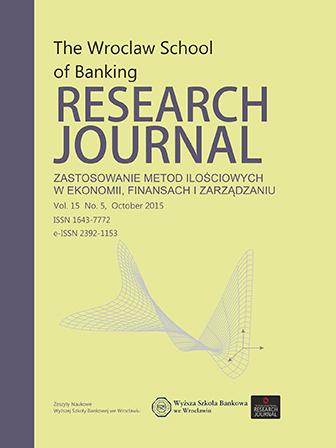Testowanie współzależności w rozwoju gospodarczym
DOI:
https://doi.org/10.29015/cerem.196Słowa kluczowe:
wielorównaniowy model GARCH, specyfikacja modelu, rozwój gospodarczyAbstrakt
Celem zaprezentowanych w niniejszej pracy badań jest analiza współzależności kształtowania się rozwoju gospodarczego Polski i Wielkiej Brytanii. Przedstawiony zostanie wielorównaniowy model GARCH, prezentujący wzajemne relatywne powiązania w zakresie dynamiki rozkładów empirycznych ze szczególnym zwróceniem uwagi na dynamikę wartości oczekiwanych i wariancji.Bibliografia
Bollerslev T. (2009), Modelling the Coherence In Short-Run Nominal Exchange Rates: A Mul-tivariate Generalized ARCH Approach, „Review of Economics and Statistics”, 72.
Choi K., Hyung N. (2011), Measuring Volatility Spillovers, Department of Economics, Uni-versity of Seoul, Seoul, Korea.
Drozdowić-Bieć M. (2006), Wskaźniki wyprzedzające. Prace i materiały INSTYTUTU ROZ-WOJU GOSPODARCZEGO, Warszawa, SGH.
Doman M., Doman R. (2004), Ekonometryczne modelowanie dynamiki polskiego rynku finan-sowego. Poznań, Wydawnictwo Akademii Ekonomicznej w Poznaniu.
Doman M., Doman R. (2009), Modelowanie zmienności i ryzyka, Kraków, Wolters Kluwer Polska.
Engle R.F. (2002), Dynamic Conditional Correlation – A Simple Class of Multivariate GARCH Models, „Journal of Business and Economic Statistics”, 20.
Fiszeder P. (2009), Modele klasy GARCH w empirycznych badaniach finansowych., Toruń, Wydawnictwo Naukowe Uniwersytetu Mikołaja Kopernika.
Franco Ch., Zakoian J.M. (2009), GARCH models. Structure, statistical inference and financial applications, New York.
Hellwig Z. (1997), Ekspansja gospodarcza Polski końca XX wieku, Poznań, Wydawnictwo Wyższej Szkoły Bankowej.
Hosking J. (1980), The Multivariate Portmanteau Statistic, „Journal of American Statistical Association”.
Janiga-Ćmiel A. (2013), Analiza zależności przyczynowych rozwoju gospodarczego Polski i wybranych państw Unii Europejskiej, „Studia Ekonomiczne”, Zeszyty Naukowe Wydziało-we 159, Katowice, Wydawnictwo Uniwersytetu Ekonomicznego w Katowicach.
Skrzypczyński P. (2006), Analiza synchronizacji cykli koniunkturalnych w strefie euro, War-szawa, NBP.
Nakatani T., Teräsvirta T. (2009a), Appendix to Testing for volatility interactions in the constant conditional correlation GARCH model, Department of Economic Statistics, Stockholm School of Economics.
Nakatani T., Teräsvirta T. (2009b), Testing for volatility interactions in the constant conditional correlation GARCH model, „The Econometrics Journal” 12.
Nakatani T. (2010), Four Essays on Building Conditional Correlation GARCH Model, De-partment of Economic Statistics, Stockholm School of Economics.
Wang P. (2003), Financial Econometrics. Methods and Models, Routledge Chapman & Hall.
Yamarone R. (2006), Wskaźniki ekonomiczne: przewodnik dla inwestora, Wydawnictwo He-lion.
Pobrania
Numer
Dział
Licencja
Autor przenosi nieodpłatnie na Wyższą Szkołę Bankową we Wrocławiu , bez ograniczeń terytorialnych, majątkowe prawa autorskie do tego utworu w rozumieniu ustawy z dnia 4 lutego 1994 roku o prawie autorskim i prawach pokrewnych ( Dz.U. 1994, Nr 24, poz. 83 ze zm. )na zasadzie wyłączności, tj. prawo do:
a) wyłącznego używania i wykorzystania utworu w dowolnej działalności przez Wyższą Szkołę Bankową we Wrocławiu, w szczególności w działalność Biblioteki Cyfrowej uruchomionej przez Wyższą Szkołę Bankową we Wrocławiu
b) wytwarzania, utrwalania i zwielokrotniania egzemplarzy utworów wszelkimi technikami, w tym techniką drukarską, reprograficzną, zapisu magnetycznego oraz techniką cyfrową, w szczególności ich zwielokrotniania poprzez dokonywanie zapisów na płytach typu CD,
c) zamieszczenia wybranych fragmentów utworu w celach promocyjnych w publikacjach, materiałach promocyjnych, w sieci Internet oraz sieciach wewnętrznych typu Intranet Wyższej Szkoły Bankowej we Wrocławiu,
d) wprowadzania utworu do pamięci komputera Wyższej Szkoły Bankowej we Wrocławiu,
e) kopiowania i powielania utworu w technologiach fotomechanicznych lub innych znanych w dniu zawarcia umowy (fotokopie, kserokopie itp.),
f) przetworzenia dzieła na formę elektroniczną i nieograniczonego rozpowszechniania w sieci Internet.


